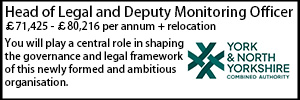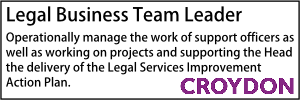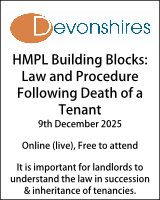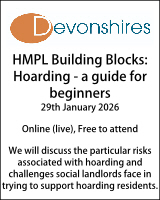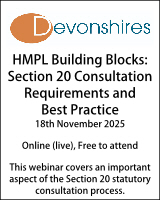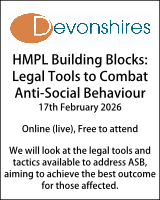Blurring the lines
The Coroners & Justice Bill 2009 aims to deliver a more effective, transparent and responsive coronial system. Fiona Butler, who recently represented Leicestershire County Council in the inquests into the deaths of Fiona Pilkington and Francecca Hardwick, examines the wider scope inquests can take and how local authorities should be prepared.
Article 2 of the Human Rights Act 1998 ensures that everyone’s right to life is protected by law. The extent of Article 2’s involvement in inquests has been the subject of some debate through the courts over recent years.
This has had the overall effect of a widening of the question of ‘how’ a deceased came by their death, so that a coroner does not just look at ‘by what means’ somebody died, but looks at ‘by what means and in what circumstances’?
The issue of negligence is not a consideration for the coroner but in cases where negligence is suspected, the coroner has an obligation to make thorough investigation into the state’s role in the individual losing their life. Whilst the courts have held that it will only be in exceptional cases, in practice the exception is fast becoming the rule.
The Pilkington case
Recent news headlines reported ‘mother kills herself and daughter in car fire after years of anti-social abuse’.
The inquest into the deaths of Fiona Pilkington and her disabled daughter, Francecca Hardwick, held before a jury because the deaths concerned issues of general public safety, was a six-day inquiry into the actions of two local authorities, their systems and their procedures for protecting vulnerable people.
The police, the district council and the county council had considered it appropriate after the deaths to conduct a serious case review. However, the coroner’s inquest examined in much wider detail the actions of each agent of the state and their potential failings in protecting the lives of this mother and her daughter.
There are no rules of evidence in a coroner’s inquest, and whilst questions should not seek to determine criminal or civil liability, or impose the coroner’s own opinions upon a witness, the investigative nature of questions which aim to determine whether there have been any failings which contributed to the death of an individual, can nevertheless be searching and fierce. In the Pilkington and Hardwicke inquest, witnesses were called to account to answer such questions in full display of the world’s media.
The jury found themselves having to grapple with understanding complicated police reporting and recording systems, the criminal justice system, anti-social behaviour legislation, the remit of the district council in tackling anti-social behaviour and the role and function of social services, its infrastructure and the responsibilities of the transitions team.
Unlike any other court, the jury play an integral role in the inquest procedure. They have the ability to ask questions of each witness called. The evidence given by those representing a local authority must be simplistic and clear, avoiding management or local authority ‘speak’.
Prevention of Future Deaths
Coroners are encouraged to look to the future to ensure that similar deaths do not reoccur. This obligation is not new, but the government has recently strengthened its remit. There is now a statutory duty on organisations receiving reports from the coroner to respond and for the first time there is a mechanism to ensure national oversight, so that lessons learned can be disseminated.
The key changes are:
- coroners have a wider remit to make reports to prevent future deaths. It does not have to be a similar death;
- a person who receives a report must send the coroner a written response within 56 days;
- coroners must provide interested persons to the inquest and the Lord Chancellor with a copy of the report and the response;
- the Lord Chancellor may publish the report and response, or a summary of them.
Previously coroners were limited to writing reports where they believed that action should be taken to prevent the recurrence of similar fatalities. The amended rule has been widened so that coroners may now make reports to prevent any other deaths based on the evidence heard at an inquest. This will allow the coroner to report issues that may be peripheral to the current case but nevertheless prevent deaths in the future.
Whilst the amended rule does not impose a sanction on organisations that fail to respond to a recommendation, the failure of a specific organisation to respond may be recorded in any document the Lord Chancellor publishes and hence subject to public scrutiny, no doubt through the media. Those giving evidence on behalf of a local authority need to anticipate and address the potential for a recommendation and negate the need for the coroner to make a recommendation.
Investigating child deaths
From 1 April 2008, Local Safeguarding Children’s Boards have had a statutory responsibility to conduct reviews into all child deaths for children who were normally resident in a local authority area. Coroners are now under a statutory duty to share information with local authorities in deaths concerning children and this allows coroners and LSCBs to work together to enable LSCBs to meet their obligation to conduct child death reviews and to fulfil their statutory obligations more generally. Whilst there is no current statutory requirement to hold a serious case review, information sharing between the coroner and local authorities in cases of adult deaths will no doubt be equally encouraged.
The future
Where Article 2 of the Human Rights Act 1998 is engaged, inquests take the form of hearings of close public scrutiny such that there is little distinction between this style of inquest and a public inquiry.
Local authorities who have the misfortune of coming before a coroner for an inquest where safeguarding issues or health and safety issues arise need to be prepared for the level of scrutiny to which they will be subjected. A too narrow focus will leave the authority and their witnesses exposed.
Early input from legal advisors experienced in coronial law is necessary. Carefully prepared evidence can avoid a coroner’s recommendation. If mistakes have occurred that fact should be accepted at an early stage. Local authorities should demonstrate a proactive approach in investigating failings and making improvements to working practices.
This proactive approach will save the embarrassment of receiving a recommendation two years after a death has occurred which suggests that practices have remained flawed in the interim between death and the inquest.
Fiona Butler is a barrister at Browne Jacobson.
- Details
The Coroners & Justice Bill 2009 aims to deliver a more effective, transparent and responsive coronial system. Fiona Butler, who recently represented Leicestershire County Council in the inquests into the deaths of Fiona Pilkington and Francecca Hardwick, examines the wider scope inquests can take and how local authorities should be prepared.
Article 2 of the Human Rights Act 1998 ensures that everyone’s right to life is protected by law. The extent of Article 2’s involvement in inquests has been the subject of some debate through the courts over recent years.
This has had the overall effect of a widening of the question of ‘how’ a deceased came by their death, so that a coroner does not just look at ‘by what means’ somebody died, but looks at ‘by what means and in what circumstances’?
The issue of negligence is not a consideration for the coroner but in cases where negligence is suspected, the coroner has an obligation to make thorough investigation into the state’s role in the individual losing their life. Whilst the courts have held that it will only be in exceptional cases, in practice the exception is fast becoming the rule.
The Pilkington case
Recent news headlines reported ‘mother kills herself and daughter in car fire after years of anti-social abuse’.
The inquest into the deaths of Fiona Pilkington and her disabled daughter, Francecca Hardwick, held before a jury because the deaths concerned issues of general public safety, was a six-day inquiry into the actions of two local authorities, their systems and their procedures for protecting vulnerable people.
The police, the district council and the county council had considered it appropriate after the deaths to conduct a serious case review. However, the coroner’s inquest examined in much wider detail the actions of each agent of the state and their potential failings in protecting the lives of this mother and her daughter.
There are no rules of evidence in a coroner’s inquest, and whilst questions should not seek to determine criminal or civil liability, or impose the coroner’s own opinions upon a witness, the investigative nature of questions which aim to determine whether there have been any failings which contributed to the death of an individual, can nevertheless be searching and fierce. In the Pilkington and Hardwicke inquest, witnesses were called to account to answer such questions in full display of the world’s media.
The jury found themselves having to grapple with understanding complicated police reporting and recording systems, the criminal justice system, anti-social behaviour legislation, the remit of the district council in tackling anti-social behaviour and the role and function of social services, its infrastructure and the responsibilities of the transitions team.
Unlike any other court, the jury play an integral role in the inquest procedure. They have the ability to ask questions of each witness called. The evidence given by those representing a local authority must be simplistic and clear, avoiding management or local authority ‘speak’.
Prevention of Future Deaths
Coroners are encouraged to look to the future to ensure that similar deaths do not reoccur. This obligation is not new, but the government has recently strengthened its remit. There is now a statutory duty on organisations receiving reports from the coroner to respond and for the first time there is a mechanism to ensure national oversight, so that lessons learned can be disseminated.
The key changes are:
- coroners have a wider remit to make reports to prevent future deaths. It does not have to be a similar death;
- a person who receives a report must send the coroner a written response within 56 days;
- coroners must provide interested persons to the inquest and the Lord Chancellor with a copy of the report and the response;
- the Lord Chancellor may publish the report and response, or a summary of them.
Previously coroners were limited to writing reports where they believed that action should be taken to prevent the recurrence of similar fatalities. The amended rule has been widened so that coroners may now make reports to prevent any other deaths based on the evidence heard at an inquest. This will allow the coroner to report issues that may be peripheral to the current case but nevertheless prevent deaths in the future.
Whilst the amended rule does not impose a sanction on organisations that fail to respond to a recommendation, the failure of a specific organisation to respond may be recorded in any document the Lord Chancellor publishes and hence subject to public scrutiny, no doubt through the media. Those giving evidence on behalf of a local authority need to anticipate and address the potential for a recommendation and negate the need for the coroner to make a recommendation.
Investigating child deaths
From 1 April 2008, Local Safeguarding Children’s Boards have had a statutory responsibility to conduct reviews into all child deaths for children who were normally resident in a local authority area. Coroners are now under a statutory duty to share information with local authorities in deaths concerning children and this allows coroners and LSCBs to work together to enable LSCBs to meet their obligation to conduct child death reviews and to fulfil their statutory obligations more generally. Whilst there is no current statutory requirement to hold a serious case review, information sharing between the coroner and local authorities in cases of adult deaths will no doubt be equally encouraged.
The future
Where Article 2 of the Human Rights Act 1998 is engaged, inquests take the form of hearings of close public scrutiny such that there is little distinction between this style of inquest and a public inquiry.
Local authorities who have the misfortune of coming before a coroner for an inquest where safeguarding issues or health and safety issues arise need to be prepared for the level of scrutiny to which they will be subjected. A too narrow focus will leave the authority and their witnesses exposed.
Early input from legal advisors experienced in coronial law is necessary. Carefully prepared evidence can avoid a coroner’s recommendation. If mistakes have occurred that fact should be accepted at an early stage. Local authorities should demonstrate a proactive approach in investigating failings and making improvements to working practices.
This proactive approach will save the embarrassment of receiving a recommendation two years after a death has occurred which suggests that practices have remained flawed in the interim between death and the inquest.
Fiona Butler is a barrister at Browne Jacobson.
22-10-2025 4:00 pm
05-11-2025 4:00 pm








